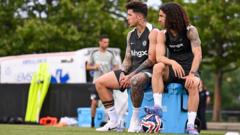Can Chelsea Overcome Record Heat in Philadelphia?

Understanding Extreme Heat: How It Affects Training and Performance in Sports
Philadelphia is currently experiencing extreme heat conditions, with temperatures expected to soar over 100°F (37.78°C) for the first time in 13 years. Such weather not only poses a challenge for daily life but also significantly impacts athletic performance, training sessions, and game strategies. As professional sports teams like Chelsea face these harsh conditions during the Club World Cup, it's crucial to understand how extreme temperatures can affect both players and teams.
Impact of High Temperatures on Training Sessions
When temperatures rise, training regimens must adapt to ensure player safety and performance. Chelsea’s manager, Enzo Maresca, emphasized the difficulty of conducting normal training sessions under a "code red" severe heat warning. The combination of high temperatures and humidity creates an environment that can lead to heat-related illnesses, making it essential for teams to modify their approach.
Heat Stress and Its Implications
Heat stress occurs when the body is unable to cool itself down effectively. In high temperatures, players may experience:
- Dehydration: Excessive sweating can lead to a loss of essential fluids and electrolytes.
- Heat Exhaustion: Symptoms include dizziness, fatigue, and even fainting.
- Heat Stroke: A severe condition that can be life-threatening, characterized by a high body temperature and confusion.
In extreme heat, as Maresca noted, training sessions need to be significantly shorter. The focus shifts from high-intensity drills to maintaining energy levels and preparing specifically for upcoming matches.
Strategies for Training in Extreme Heat
To counteract the adverse effects of high temperatures, teams should implement specific strategies during training:
1. Adjust Training Times
Scheduling training sessions during cooler parts of the day—early morning or late afternoon—can help mitigate the heat's intensity. This allows players to train more effectively while reducing the risk of heat-related issues.
2. Hydration is Key
Ensuring players stay hydrated is crucial. Medical staff should monitor fluid intake, and teams should provide ample access to water and electrolyte drinks. During Chelsea's training, crates of iced water bottles were strategically placed around the pitch to encourage regular hydration.
3. Modify Training Intensity
Instead of maintaining high-intensity workouts, focus on lighter drills that allow players to acclimatize to the heat without overexerting themselves. Maresca’s approach of conducting shorter sessions keeps the players engaged while preserving their energy for competition.
4. Utilize Cooling Equipment
Teams can benefit from using cooling technology, such as:
- Fans: Large fans can create airflow and help cool down players.
- Cooling Vests: These can be worn during breaks to help lower body temperatures.
- Water Spray Systems: Mist or spray systems can provide immediate relief from heat.
Challenges of Competing in Extreme Heat
As Chelsea prepares for their final Group D match against ES Tunis, the extreme heat presents significant challenges. The need to perform under such conditions raises concerns about player fatigue and the effectiveness of their gameplay. Other teams, like Borussia Dortmund and Atletico Madrid, have also expressed difficulties in adapting to high temperatures, as managers and players alike find it challenging to maintain performance levels.
Player Health and Performance
Players are at risk not only of heat-related illnesses but also of decreased performance. The body’s ability to function optimally diminishes when temperatures rise, leading to:
- Slower Reaction Times: High heat can slow down cognitive functions, impacting decision-making on the field.
- Reduced Stamina: Players may tire more quickly, affecting their overall performance during matches.
- Increased Injury Risk: Fatigue can lead to poor technique and higher chances of injury.
Preparing for Future Tournaments
With the United States set to co-host the World Cup next year, the concerns surrounding extreme heat underscore the importance of preparing for such conditions. Teams and organizers must develop comprehensive plans to ensure player safety while maintaining the integrity of the game.
1. Acclimatization Programs
Implementing acclimatization programs that gradually expose players to heat can help them adapt more effectively. Such programs include:
- Gradual increases in training intensity and duration in warm conditions.
- Education on recognizing heat stress symptoms.
2. Policy Changes
Sports governing bodies may need to revise policies regarding game timing and scheduling during extreme weather conditions. Considerations for player safety should take precedence, including possibly rescheduling matches to avoid peak heat hours.
3. Enhanced Medical Support
Having a robust medical team on-site during training and matches is crucial for monitoring player conditions. Regular health checks, hydration assessments, and immediate access to cooling facilities can help mitigate risk.
Conclusion
The extreme heat currently facing Philadelphia highlights the challenges athletes encounter in high-temperature environments. As teams like Chelsea adapt their training and game strategies, it becomes clear that effective management of heat stress is essential for maintaining player performance and safety. With future tournaments approaching, addressing these issues will be vital for the well-being of athletes.
As we move forward, the question arises: How can sports organizations further innovate to protect players while ensuring the excitement of competition remains intact?
FAQs
What are the signs of heat exhaustion in athletes?
Signs of heat exhaustion include heavy sweating, weakness, dizziness, nausea, headache, and confusion. If these symptoms occur, it's crucial to stop all activities and seek medical attention.
How can teams prepare for training in extreme heat?
Teams can prepare by adjusting training times, ensuring proper hydration, modifying training intensity, and utilizing cooling equipment to help players cope with high temperatures.
What should players do if they start feeling ill during training?
If players start feeling ill, they should immediately report their symptoms to a coach or medical staff, stop all physical activity, and seek assistance to cool down and hydrate.
As we approach the heat of summer and the excitement of sports, how do you think teams will adapt to ensure player safety and performance? #HeatManagement #SportsPerformance #PlayerSafety
Published: 2025-06-23 19:45:21 | Category: sport



